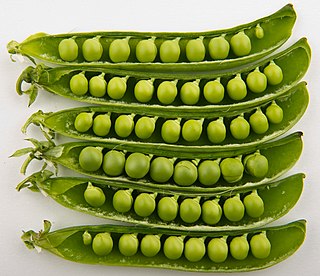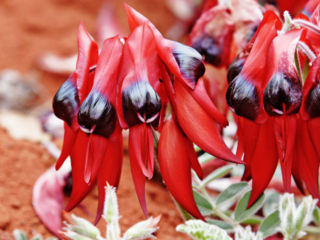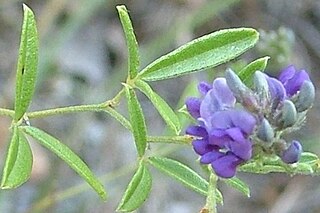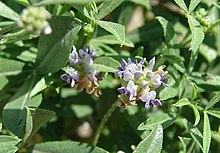
A bean is the seed of several plants in the family Fabaceae, which are used as vegetables for human or animal food. They can be cooked in many different ways, including boiling, frying, and baking, and are used in many traditional dishes throughout the world.

Gregor Johann MendelOSA was a German-Czech biologist, meteorologist, mathematician, Augustinian friar and abbot of St. Thomas' Abbey in Brno (Brünn), Margraviate of Moravia. Mendel was born in a German-speaking family in the Silesian part of the Austrian Empire and gained posthumous recognition as the founder of the modern science of genetics. Though farmers had known for millennia that crossbreeding of animals and plants could favor certain desirable traits, Mendel's pea plant experiments conducted between 1856 and 1863 established many of the rules of heredity, now referred to as the laws of Mendelian inheritance.

The pea is most commonly the small spherical seed or the seed-pod of the flowering plant species Lathyrus oleraceus. Each pod contains several peas, which can be green or yellow. Botanically, pea pods are fruit, since they contain seeds and develop from the ovary of a (pea) flower. The name is also used to describe other edible seeds from the Fabaceae such as the pigeon pea, the cowpea, and the seeds from several species of Lathyrus.

The Faboideae are a subfamily of the flowering plant family Fabaceae or Leguminosae. An acceptable alternative name for the subfamily is Papilionoideae, or Papilionaceae when this group of plants is treated as a family.

Lathyrus is a genus of flowering plants in the legume family Fabaceae, and contains approximately 160 species. Commonly known as peavines or vetchlings, they are native to temperate areas, with a breakdown of 52 species in Europe, 30 species in North America, 78 in Asia, 24 in tropical East Africa, and 24 in temperate South America. There are annual and perennial species which may be climbing or bushy. This genus has numerous sections, including Orobus, which was once a separate genus. The genus has numerous synonyms, including Pisum, the ancient Latin name for the pea.

A legume is a plant in the family Fabaceae, or the fruit or seed of such a plant. When used as a dry grain, the seed is also called a pulse. Legumes are grown agriculturally, primarily for human consumption, for livestock forage and silage, and as soil-enhancing green manure. Well-known legumes include beans, soybeans, chickpeas, peanuts, lentils, lupins, grass peas, mesquite, carob, tamarind, alfalfa, and clover. Legumes produce a botanically unique type of fruit – a simple dry fruit that develops from a simple carpel and usually dehisces on two sides.

The black-eyed pea or black-eyed bean is a legume grown around the world for its medium-sized, edible bean. It is a subspecies of the cowpea, an Old World plant domesticated in Africa, and is sometimes simply called a cowpea.

Swainsona formosa, Sturt's desert pea, is an Australian plant in the genus Swainsona, named after English botanist Isaac Swainson, famous for its distinctive blood-red leaf-like flowers, each with a bulbous red or black centre, or "boss". It is one of Australia's best known wildflowers. It is native to the arid regions of central and north-western Australia, and its range extends into all mainland Australian states with the exception of Victoria.

The snap pea, also known as the sugar snap pea, is an edible-pod pea with rounded pods and thick pod walls, in contrast to snow pea pods, which are flat with thin walls. The name mangetout can apply to snap peas and snow peas.

The sweet pea, Lathyrus odoratus, is a flowering plant in the genus Lathyrus in the family Fabaceae (legumes), native to Sicily, southern Italy and the Aegean Islands.

Split peas are an agricultural or culinary preparation consisting of the dried, peeled and split seeds of Pisum sativum, the pea.

The snow pea is an edible-pod pea with flat pods and thin pod walls. It is eaten whole, with both the seeds and the pod, while still unripened.

Clitoria ternatea, commonly known as Asian pigeonwings, bluebellvine, blue pea, butterfly pea, cordofan pea or Darwin pea, is a plant species belonging to the family Fabaceae, endemic and native to the Indonesian island of Ternate.
A scurfpea is a legume that may belong to any of several genera of plants, including:

Pediomelum is a genus of legumes known as Indian breadroots. These are glandular perennial plants with palmately-arranged leaves. They have a main erect stem with inflorescences of blue or purple flowers and produce hairy legume pods containing beanlike seeds. Some species have woody roots while others have starchy tuber-like roots which can be eaten like tuber vegetables such as potatoes or made into flour. Indian breadroots are native to North America. Many species have synonymy with genus Psoralea.

Psoralidium lanceolatum is a species of flowering plant in the legume family known by several common names, including lemon scurfpea, wild lemonweed, and dune scurfpea.

Psoralidium tenuiflorum, the slimflower scurfpea, is a perennial in the pea family. It is about 2–3 feet (0.6–0.9 m) tall and has a lot of leaves on top. Its leaves can reach a length of 3 inches (80 mm). This flower can be found mainly in the central and southwestern U.S.

The pigeon pea is a perennial legume from the family Fabaceae native to the Old World. The pigeon pea is widely cultivated in tropical and semitropical regions around the world, being commonly consumed in South Asia, Southeast Asia, Africa, Latin America and the Caribbean.
Psoralidium junceum is a species of flowering plant in the legume family, commonly known as rush lemonweed, or rush scurfpea. It is native to southwestern North America where it is only known from Arizona and Utah. It grows on sand dunes, among shrubs on semi-stabilized sands, on mudflats encrusted with salt and on bare rocky slopes.

















